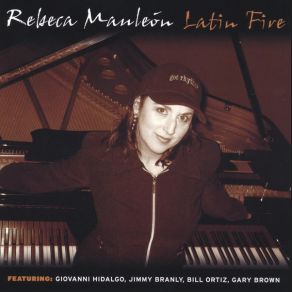Latin Fire
Download links and information about Latin Fire by Rebeca Mauleón / Rebeca Mauleon. This album was released in 2004 and it belongs to Salsa, Latin genres. It contains 11 tracks with total duration of 53:38 minutes.

|
|
|---|---|
| Artist: | Rebeca Mauleón / Rebeca Mauleon |
| Release date: | 2004 |
| Genre: | Salsa, Latin |
| Tracks: | 11 |
| Duration: | 53:38 |
| Buy it NOW at: | |
| Buy on iTunes $9.99 | |
| Buy on Amazon $8.99 | |
Tracks
[Edit]| No. | Title | Length |
|---|---|---|
| 1. | Batamambo | 5:21 |
| 2. | Cuba Hermosa | 4:56 |
| 3. | Fuego | 5:03 |
| 4. | A la Rumba | 5:53 |
| 5. | Te Canto Puerto Rico | 4:48 |
| 6. | Ritmo Caribeno | 5:17 |
| 7. | Ven Conmigo | 3:20 |
| 8. | La Ventana | 4:42 |
| 9. | CuBrazil | 4:58 |
| 10. | Pa' Lante | 4:40 |
| 11. | La Ventana (D.J. Mix) | 4:40 |
Details
[Edit]When people speak of Latin jazz, they usually mean Afro-Cuban jazz — a rich tradition associated with heavyweights like Cal Tjader, Tito Puente, Poncho Sanchez, Mongo Santamaria, Ray Barretto, Arturo Sandoval and Eddie Palmieri. But technically, the term Latin jazz could also be used to describe jazz that is mixed with Argentinean tango, Dominican merengue, Spanish flamenco, Venezuelan joropo or any other form of Latin music. So when one is discussing Latin music, it is always a good idea to be as specific as possible and note what types of Latin rhythms are being used. In the case of Rebeca Mauleón's enjoyable Latin Fire, Latin usually means Afro-Cuban. This 2004 release has one foot in instrumental Afro-Cuban jazz and the other in vocal-oriented salsa (an umbrella term that has, since the '70s, been applied to son, cha-cha, guaguancó, mambo and other rhythms that came out of Cuba). Mauleón, quite honestly, is a better musician than singer; she is a fine pianist/keyboardist, whereas her vocals are merely adequate. But Mauleón (whose vocals favor either Spanish lyrics or wordless scat-singing) always gets her creative points across, and Latin Fire maintains its momentum whether she is providing salsa-influenced jazz or jazz-influenced salsa. Occasionally, Latin Fire acknowledges some Latin rhythms that didn't originated in Cuba and aren't part of what is generally known as salsa. The ethereal "CuBrazil," for example, finds Mauleón scatting over a groove that is part samba and part Afro-Cuban descarga — an appealing combination, certainly. But Afro-Cuban rhythms are the Latin rhythms that she obviously knows best. That's her area of expertise, and Mauleón's Afro-Cuban orientation serves her well on this pleasing, if derivative, effort.